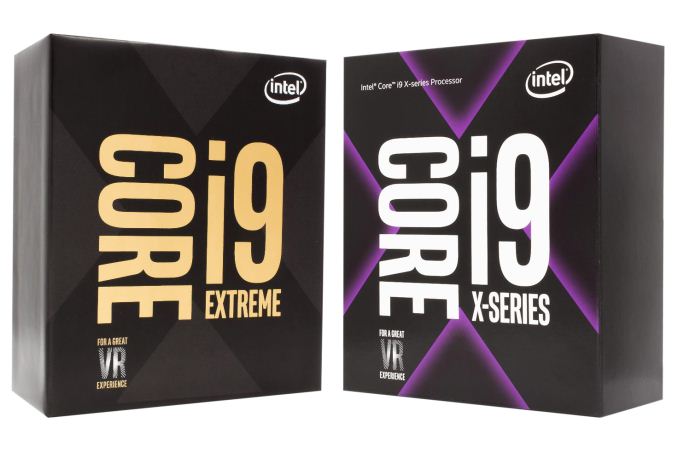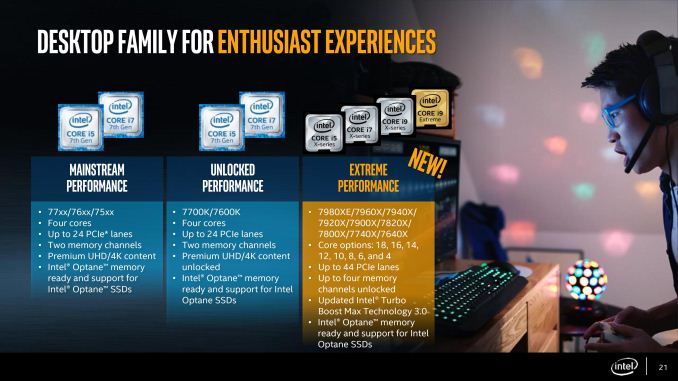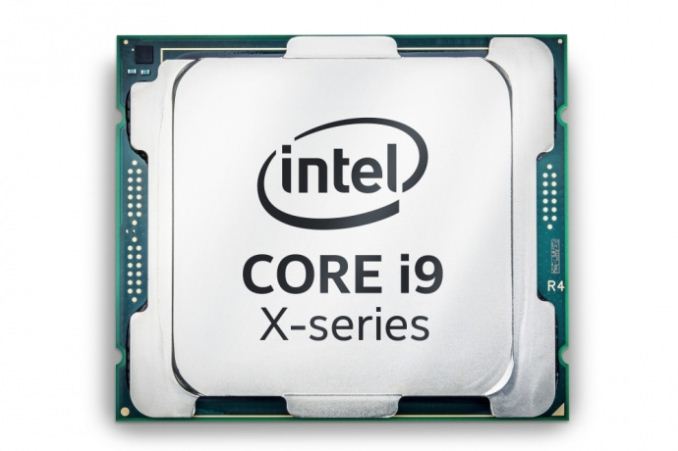Intel Announces Skylake-X: Bringing 18-Core HCC Silicon to Consumers for $1999
by Ian Cutress on May 30, 2017 3:03 AM EST
There are days in this profession in which I am surprised. The longer I stay in the technology industry, they become further and further apart. There are several reasons to be surprised: someone comes out of the blue with a revolutionary product and the ecosystem/infrastructure to back it up, or a company goes above and beyond a recent mediocre pace to take on the incumbents (with or without significant financial backing). One reason is confusion, as to why such a product would ever be thought of, and another is seeing how one company reacts to another.
We’ve been expecting the next high-end desktop version of Skylake for almost 18 months now, and fully expected it to be an iterative update over Broadwell-E: a couple more cores, a few more dollars, a new socket, and done. Intel has surprised us with at least two of the reasons above: Skylake-X will increase the core count of Intel’s HEDT platform from 10 to 18.
The Skylake-X announcement is a lot to unpack, and there are several elements to the equation. Let’s start with familiar territory: the first half of the processor launch.
Announcement One: Low Core Count Skylake-X Processors
The last generation, Broadwell-E, offered four processors: two six-core parts, an eight-core part, and a top-tier 10-core processor. The main difference between the two six-core parts was the PCIe lane count, and aside from the hike in pricing for the top-end SKU, these were iterative updates over Haswell-E: two more cores for the top processor.
This strategy from Intel is derived from what they call internally as their ‘LCC’ core, standing for ‘low core count’. The enterprise line from Intel has three designs for their silicon – a low core count, a high core count, and an extreme core count: LCC, HCC, and XCC respectively. All the processors in the enterprise line are typically made from these three silicon maps: a 10-core LCC silicon die, for example, can have two cores disabled to be an 8-core. Or a 22-core XCC die can have all but four cores disabled, but still retain access to all the L3 cache, to have an XCC processor that has a massive cache structure. For the consumer HEDT platform, such as Haswell-E and Broadwell-E, the processors made public were all derived from the LCC silicon.
The first half of the Skylake-X processor llineup follows this trend. Intel will launch four Skylake-X processors based on the LCC die, which for this platform will have a maximum of 12 cores. All processors will have hyperthreading.
| Skylake-X Processors (Low Core Count Chips) | ||||
| Core i7-7800X | Core i7-7820X | Core i9-7900X | Core i9-7920X | |
| Cores/ Threads |
6/12 | 8/16 | 10/20 | 12/24 |
| Base Clock | 3.5 GHz | 3.6 GHz | 3.3 GHz | TBD |
| Turbo Clock | 4.0 GHz | 4.3 GHz | 4.3 GHz | TBD |
| TurboMax Clock | N/A | 4.5 GHz | 4.5 GHz | TBD |
| L3 | 8.25 MB | 11 MB | 13.75 MB | TBD (Likely 13.75 MB) |
| PCIe Lanes | 28 | 44 | TBD (Likely 44) |
|
| Memory Channels | 4 | |||
| Memory Freq | DDR4-2400 | DDR4-2666 | TBD | |
| TDP | 140W | TBD | ||
| Price | $389 | $599 | $999 | $1199 |
The bottom processor is the Core i7-7800X, running at 3.5 GHz with a 4.0 GHz turbo. This design will not feature Intel’s new ‘favored core’ Turbo 3.0 technology (more on that below), but will have six cores, support quad-channel memory at DDR4-2400, come in at a TDP of 140W, have 28 PCIe lanes, and retail for around $400. This processor will be the entry level model, for any user who needs the benefit of quad-channel memory but perhaps doesn’t need a two-digit number of cores or has a more limited budget.
Next up is the Core i7-7820X, which hits a potential sweet spot in the LCC design. This is an eight-core processor, with the highest LCC base clock of 3.6 GHz and the joint-highest turbo settings: 4.3 GHz for regular turbo and 4.5 GHz for favored core. Unlike the previous processor, this CPU gets support for DDR4-2666 memory.
However in another break from Intel’s regular strategy, this CPU will only support 28 PCIe lanes. Normally only the lowest CPU of the HEDT stack would be adjusted in this way, but Intel is using the PCIe lane allocation as another differentiator as a user considers which processor in the stack to go for. This CPU also runs in at 140W, and comes in at $600. At this price, we would expect it to be competing directly against AMD’s Ryzen 7 1800X, which will be the equivalent of a generation behind in IPC but $100 cheaper.
| Comparison: Core i7-7820X vs. Ryzen 7 1800X | ||
| Intel Core i7-7820X |
Features | AMD Ryzen 7 1800X |
| 8 / 16 | Cores/Threads | 8 / 16 |
| 3.6 / 4.3GHz (4.5 GHz TMax) |
Base/Turbo | 3.6 / 4.0 GHz |
| 28 | PCIe 3.0 Lanes | 16 |
| 11 MB | L3 Cache | 16 MB |
| 140 W | TDP | 95 W |
| $599 | Price (MSRP) | $499 |
The third processor is also a change for Intel. Here is the first processor bearing the new Core i9 family. Previously we had Core i3, i5 and i7 for several generations. This time out, Intel deems it necessary to add another layer of differentiation in the naming, so the Core i9 naming scheme was the obvious choice. If we look at what the Core i9 name brings to the table, the obvious improvement is PCIe lanes: Core i7 processors will have 28 PCIe lanes, while Core i9 processors will have 44 PCIe lanes. This makes configuring an X299 motherboard a little difficult: see our piece on X299 to read up on why.
Right now the Core i9-7900X is the only Core i9 with any details: this is a ten core processor, running with a 3.3 GHz base, a 4.3 GHz turbo and a 4.5 GHz favored core. Like the last processor, it will support DDR4-2666 and has a TDP of 140W. At this level, Intel is now going to charge $100/core, so this 10-core part runs in at a $999 tray price ($1049 retail likely).
One brain cell to twitch when reading this specification is the price. For Ivy Bridge-E, the top SKU was $999 for six-cores. For Haswell-E, the top SKU was $999 for eight-cores. For Broadwell-E, we expected the top SKU for 10-cores to be $999, but Intel pushed the price up to $1721, due to the way the enterprise processors were priced. For Skylake-X, the new pricing scheme is somewhat scrapped again. This 10-core part is now $999, which is what we expected the Broadwell-E based Core i7-6950X to be. This isn’t the top SKU, but the pricing comes back down to reasonable levels.
Meanwhile for the initial launch of Skylake-X, it is worth noting that this 10-core CPU, the Core i9-7900X, will be the first one available to purch. More on that later.
Still covering the LCC core designs, the final processor in this stack is the Core i9-7920X. This processor will be coming out later in the year, likely during the summer, but it will be a 12-core processor on the same LGA2066 socket for $1199 (retail ~$1279), being part of the $100/core mantra. We are told that Intel is still validating the frequencies of this CPU to find a good balance of performance and power, although we understand that it might be 165W rather than 140W, as Intel’s pre-briefing explained that the whole X299 motherboard set should be ready to support 165W processors.
In the enterprise space, or at least in previous generations, Intel has always had that processor that consumed more power than the rest. This was usually called the ‘workstation’ processor, designed to be in a single or dual socket design but with a pumped up frequency and price to match. In order for Intel to provide this 12-core processor to customers, as the top end of the LCC silicon, it has to be performant, power efficient, and come in at reasonable yields. There’s a chance that not all the factors are in place yet, especially if they come out with a 12-core part that is clocked high and could potentially absorb some of their enterprise sales.
Given the expected timing and launch for this processor, as mentioned we were expecting mid-summer, that would have normally put the crosshairs into Intel’s annual IDF conference in mid-August, although that conference has now been canned. There are a few gaming events around that time to which Intel may decide to align the launch to.












203 Comments
View All Comments
WorldWithoutMadness - Tuesday, May 30, 2017 - link
18C/36T. Soon, AMD'll revise threadripper up to 20C/40T and we'd have two giant fighting of +1/+2 of each others.SunLord - Tuesday, May 30, 2017 - link
AMD can probably move to 32C/64T at any time they please as Threadripper uses the same socket as the Naples/Epyc server cpu the biggest limiter would be motherboards as they are designed to limits AMD imposed on the Threadripper system such as quad channel and 44 pcie so AMD would have to do some tweaking to make it work with those limiters.tuxfool - Tuesday, May 30, 2017 - link
AFAIK, it isn't the same socket. Threadripper uses SP3r2 whereas Epyc uses R3 sockets.Samus - Tuesday, May 30, 2017 - link
Much like Intel's HEDT CPU's use a different socket (2011 opposed to 1151) so it makes sense to have a different socket especially if more PCIe lanes are being introduced.Thank you AMD for making Intel interesting again. LOL.
ddriver - Thursday, June 1, 2017 - link
The difference is that unlike intel, amd is not going to introduce a new and incompatible socket revision for every CPU revision.Obviously, the increased number of i\o requires a new socket, so you are going to have one for mainstream, one for hedt and one for server, that is pretty much inevitable. What is achievable is socket longevity, an aspect in which intel deliberately sucks big time.
JKflipflop98 - Saturday, June 3, 2017 - link
You know, I see AMD fanboys all over the internet use this same line and it just befuddles me. Why on Earth do you even care about socket compatibilities? Why would you EVER buy a brand new CPU, then immediately castrate its performance across the board by shoving it into some old and outdated motherboard? If you're really that strapped for cash, why are you spending money on PC upgrades?ddriver - Sunday, June 4, 2017 - link
It is because you are technologically ignorant. Motherboards do not bottleneck CPUs. Even memory controllers are now integrated in the CPU, so how fast your memory is depends on the CPU, the mobo only provides the slot to plug it into.Intel is not deliberately rendering sockets obsolete to maximize performance, but to force people to purchase more mobos, thus more chipsets from them.
A good mobo can be 300-500+$ investment. That's a significant amount of money to save. It can enable to you get substantially faster CPU or GPU for that saved money.
JKflipflop98 - Thursday, June 8, 2017 - link
Amazing how many people here are completely clueless how electronics actually work. Thanks for providing an example there, ddriver. Your moronic posts never cease to entertain.cpupro - Sunday, June 18, 2017 - link
@JKflipflop98Explain why owners of original high-end expensive Intel motherboards, I think it was X99 chipset, were required to buy new motherborad while third-party motherboard manufacturers required only BIOS update to support new revision of Intel CPU for same socket?
TheinsanegamerN - Monday, June 5, 2017 - link
"old and outdated" doesnt really apply anymore. The only difference between my p8z77 v-pro and a brand new mobo is the number of USB 3 ports. other than that, it does everything I need it to.It isnt the 90s when mobo designs were leaping ahead.